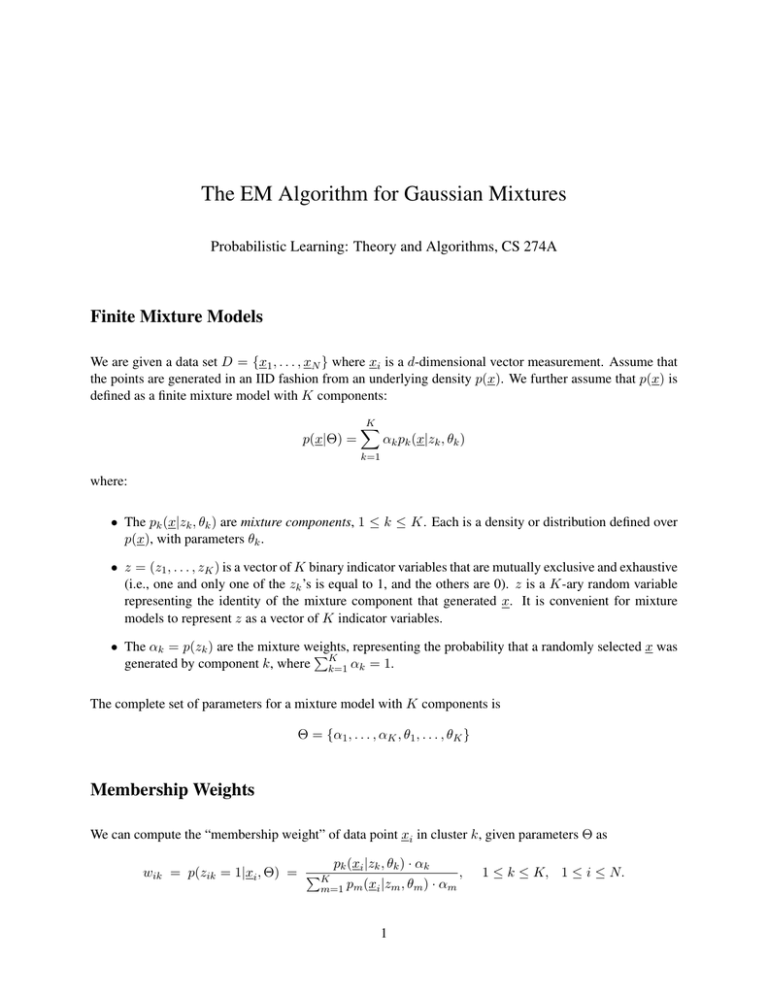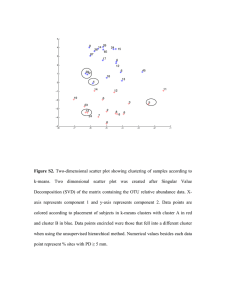The EM Algorithm for Gaussian Mixtures
advertisement

The EM Algorithm for Gaussian Mixtures
Probabilistic Learning: Theory and Algorithms, CS 274A
Finite Mixture Models
We are given a data set D = {x1 , . . . , xN } where xi is a d-dimensional vector measurement. Assume that
the points are generated in an IID fashion from an underlying density p(x). We further assume that p(x) is
defined as a finite mixture model with K components:
p(x|Θ) =
K
X
αk pk (x|zk , θk )
k=1
where:
• The pk (x|zk , θk ) are mixture components, 1 ≤ k ≤ K. Each is a density or distribution defined over
p(x), with parameters θk .
• z = (z1 , . . . , zK ) is a vector of K binary indicator variables that are mutually exclusive and exhaustive
(i.e., one and only one of the zk ’s is equal to 1, and the others are 0). z is a K-ary random variable
representing the identity of the mixture component that generated x. It is convenient for mixture
models to represent z as a vector of K indicator variables.
• The αk = p(zk ) are the mixture weights,
PK representing the probability that a randomly selected x was
generated by component k, where k=1 αk = 1.
The complete set of parameters for a mixture model with K components is
Θ = {α1 , . . . , αK , θ1 , . . . , θK }
Membership Weights
We can compute the “membership weight” of data point xi in cluster k, given parameters Θ as
wik = p(zik = 1|xi , Θ) = PK
pk (xi |zk , θk ) · αk
m=1 pm (xi |zm , θm )
1
· αm
,
1 ≤ k ≤ K, 1 ≤ i ≤ N.
Notes on the EM Algorithm for Gaussian Mixtures: CS 274A, Probabilistic Learning
2
This follows from a direct application of Bayes rule.
The membership weights above reflect our uncertainty, given xi and Θ, about which of the K components generated vector xi . Note that we are assuming in our generative mixture model that each xi was
generated by a single component—so these probabilities reflect our uncertainty about which component xi
came from, not any “mixing” in the generative process.
Gaussian Mixture Models
For x ∈ Rd we can define a Gaussian mixture model by making each of the K components a Gaussian
density with parameters µk and Σk . Each component is a multivariate Gaussian density
pk (x|θk ) =
1
d/2
(2π)
1
|Σk |1/2
e− 2 (x−µk )
t Σ−1 (x−µ )
k
k
with its own parameters θk = {µk , Σk }.
The EM Algorithm for Gaussian Mixture Models
We define the EM (Expectation-Maximization) algorithm for Gaussian mixtures as follows. The algorithm
is an iterative algorithm that starts from some initial estimate of Θ (e.g., random), and then proceeds to
iteratively update Θ until convergence is detected. Each iteration consists of an E-step and an M-step.
E-Step: Denote the current parameter values as Θ. Compute wik (using the equation above for membership
weights) for all data points xi , 1 ≤ i ≤ N and all mixture
1 ≤ k ≤ K. Note that for each data
Pcomponents
K
point xi the membership weights are defined such that k=1 wik = 1. This yields an N × K matrix of
membership weights, where each of the rows sum to 1.
M-Step: Now use the membership weights and the data to calculate new parameter values. Let Nk =
P
N
i=1 wik , i.e., the sum of the membership weights for the kth component—this is the effective number of
data points assigned to component k.
Specifically,
αknew =
Nk
,
N
1 ≤ k ≤ K.
These are the new mixture weights.
µnew
k
=
1
Nk
X
N
wik · xi
1 ≤ k ≤ K.
i=1
The updated mean is calculated in a manner similar to how we could compute a standard empirical average,
except that the ith data vector xi has a fractional weight wik . Note that this is a vector equation since µnew
k
and xi are both d-dimensional vectors.
Notes on the EM Algorithm for Gaussian Mixtures: CS 274A, Probabilistic Learning
Σnew
k
=
X
N
1
Nk
wik · (xi − µnew
)(xi − µnew
)t
k
k
3
1 ≤ k ≤ K.
i=1
Again we get an equation that is similar in form to how we would normally compute an empirical covariance
matrix, except that the contribution of each data point is weighted by wik . Note that this is a matrix equation
of dimensionality d × d on each side.
The equations in the M-step need to be computed in this order, i.e., first compute the K new α’s, then
the K new µk ’s, and finally the K new Σk ’s.
After we have computed all of the new parameters, the M-step is complete and we can now go back
and recompute the membership weights in the E-step, then recompute the parameters again in the E-step,
and continue updating the parameters in this manner. Each pair of E and M steps is considered to be one
iteration.
Initialization and Convergence Issues for EM
The EM algorithm can be started by either initializing the algorithm with a set of initial parameters and then
conducting an E-step, or by starting with a set of initial weights and then doing a first M-step. The initial
parameters or weights can be chosen randomly (e.g. select K random data points as initial means and select
the covariance matrix of the whole data set for each of the initial K covariance matrices) or could be chosen
via some heuristic method (such as by using the k-means algorithm to cluster the data first and then defining
weights based on k-means memberships).
Convergence is generally detected by computing the value of the log-likelihood after each iteration and
halting when it appears not to be changing in a significant manner from one iteration to the next. Note that
the log-likelihood (under the IID assumption) is defined as follows:
log l(Θ) =
N
X
i=1
K
N X
X
log p(xi |Θ) =
αk pk (xi |zk , θk )
log
i=1
k=1
where pk (xi |zk , θk ) is the Gaussian density for the kth mixture component.
The K-means Algorithm
The K-means algorithm is another algorithm for clustering real-valued data. It is based on minimizing the
sum of Euclidean distances between each point and its assigned cluster, rather than on a probabilistic model.
The algorithm takes as input an n × d data matrix (with real-valued entries), a value for K, and operates as
follows:
Notes on the EM Algorithm for Gaussian Mixtures: CS 274A, Probabilistic Learning
4
1. Initialize by randomly selecting K mean vectors, e.g., pick K data vectors (rows) randomly from the
input data matrix
2. Assign each of the n data vectors to the cluster corresponding to which of the K clusters means it is
closest to, where distance is measured as Euclidean distance in the d-dimensional input space.
3. For each cluster k, compute its new mean as the mean (average) of all the data vectors that were
assigned to this cluster in Step 2.
4. Check for convergence. An easy way to determine convergence is to execute Step 2 and check if any
of the data points change cluster assignments relative to their assignment on the previous iteration. If
not, exit; if 1 or more points change cluster assignment, continue to Step 3.
The K-means algorithm can be viewed as a heuristic search algorithm for finding the cluster assignments
that minimize the total sum of squares, namely the sum of the squared Euclidean distances from each of the
n data points to a cluster center. Finding the optimal solution is NP-hard, so K-means may converge to
local minima. For this reason it can be useful to start the algorithm multiple random starting conditions, and
select the solution with the minimum sum of squares score over different runs.
The K-means algorithm can also be thought of as a simpler non-probabilistic alternative to Gaussian
mixtures. K-means has no explicit notion of cluster covariances. One can “reduce” Gaussian mixture
clustering to K-means if one were to (a) fix a priori all the covariances for the K components to be the
identity matrix (and not update them during the M-step), and (b) during the E-step, for each data vector,
assign a membership probability of 1 for the component it is most likely to belong to, and 0 for all the other
memberships (in effect make a “hard decision” on component membership at each iteration).



